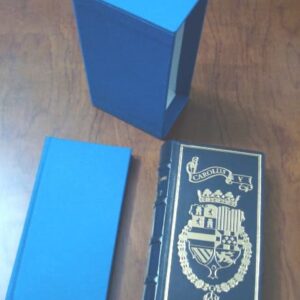Description
During the fifteenth century, the Castilian nobility, in imitation of monarchs Juan II and Isabel the Catholic, is fond of good books and form great libraries, which can be paradigm the Marquis de Santillana. the House of Zúñiga also stressed in his love of books, especially the one who was Master of the Military Order of Alcantara, Don Juan de Zuniga, for which they were written and miniaron splendid works such as Jouvencel of Juan de Breuil, in French, which is exposed in El Escorial, and probably the Book of Hours in question. A descendant of the master Alonso de Zuniga gave it to King Philip II when he learned of his intention to form in El Escorial a large library of manuscript books. Today exposed, among many other works of art in the display case 10 of the Royal Library of the monastery.
The facsimile reproduction of the codex, consisting of 254 folios, 19 x 25.6 cm., And its contents correspond to the model of the books of hours spread dramatically in the fifteenth century to meet the piety of the laity, the which came mostly from the Netherlands and Italy. This issue of the Zúñiga, however, was written and illustrated by a Spanish, of Castilian origin, who is very knowledgeable of the Flemish techniques of miniatures, but also brings French solutions and some typically Spanish in the representation of landscape, decorating the borders with issues of Toledo Mudejar and adopting false inscriptions that mimic the features of the Arabic script.
The manuscript, written in a calligraphic Gothic, contains 19 miniatures to full folio which will represent the major milestones of the life of Christ: Annunciation (on the bottom appears the shield of the Zúñiga), Visitation, Christmas, annunciation to the shepherds, etc., etc., all of the same masterly hand. The borders that frame the paintings, which are not repeated, are of a color and extraordinary luxury. From folio 223, the capitals which adorned only came there, change to introduce vignettes inside high quality, real pictures in miniature. In the calendar with which, as usual, the work starts, each month has at its top a reproduction of the typical work that he carried out and in the bottom of the corresponding zodiac sign. For example, in January the sign of Aquarius and a man sitting comfortably at the fireplace while eating and drinking appear.
Extraordinary beautiful facsimile edition in Madrid in 2003, limited and numbered. Brown leather-bound goat, printed in black on both sides, format 21,2 x 27 cm. 512 pages, sewn in handloom, gilt edges.
Book study published in 2007 and written by the professors of the University of Valladolid, Jose Manuel Ruiz Asencio and Salvador Andrés Ordax. Bound in hardcover in illustrated and gold cloth, guards with facsimiles illustrations with gold. 20.8 x 27 cm format. 168 pages. Texts in Spanish.
This beautiful Book of Hours was also originally called Don Gutierre de Sotomayor, Count of Belalcázar.
Free shipping for this item. Consult us with any questions, indicating the item reference and delivery time.



















